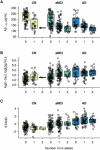Effect of apolipoprotein E on biomarkers of amyloid load and neuronal pathology in Alzheimer disease
- PMID: 20373342
- PMCID: PMC2886799
- DOI: 10.1002/ana.21953
Effect of apolipoprotein E on biomarkers of amyloid load and neuronal pathology in Alzheimer disease
Abstract
Objective: To study the effect of apolipoprotein E epsilon4 status on biomarkers of neurodegeneration (atrophy on magnetic resonance imaging [MRI]), neuronal injury (cerebrospinal fluid [CSF] t-tau), and brain Abeta amyloid load (CSF Abeta(1-42)) in cognitively normal subjects (CN), amnestic subjects with mild cognitive impairment (aMCI), and patients with Alzheimer disease (AD).
Methods: We included all 399 subjects (109 CN, 192 aMCI, 98 AD) from the Alzheimer's Disease Neuroimaging Initiative study with baseline CSF and MRI scans. Structural Abnormality Index (STAND) scores, which reflect the degree of AD-like anatomic features on MRI, were computed for each subject.
Results: A clear epsilon4 allele dose effect was seen on CSF Abeta(1-42) levels within each clinical group. In addition, the proportion of the variability in Abeta(1-42) levels explained by APOE epsilon4 dose was significantly greater than the proportion of the variability explained by clinical diagnosis. On the other hand, the proportion of the variability in CSF t-tau and MRI atrophy explained by clinical diagnosis was greater than the proportion of the variability explained by APOE epsilon4 dose; however, this effect was only significant for STAND scores.
Interpretation: Low CSF Abeta(1-42) (surrogate for Abeta amyloid load) is more closely linked to the presence of APOE epsilon4 than to clinical status. In contrast, MRI atrophy (surrogate for neurodegeneration) is closely linked with cognitive impairment, whereas its association with APOE epsilon4 is weaker. The data in this paper support a model of AD in which CSF Abeta(1-42) is the earliest of the 3 biomarkers examined to become abnormal in both APOE carriers and noncarriers.
Figures


Comment in
-
Beyond diagnosis: what biomarkers are teaching us about the "bio"logy of Alzheimer disease.Ann Neurol. 2010 Mar;67(3):283-5. doi: 10.1002/ana.22020. Ann Neurol. 2010. PMID: 20373338 No abstract available.
Similar articles
-
MRI and CSF biomarkers in normal, MCI, and AD subjects: predicting future clinical change.Neurology. 2009 Jul 28;73(4):294-301. doi: 10.1212/WNL.0b013e3181af79fb. Neurology. 2009. PMID: 19636049 Free PMC article.
-
Effect of APOE genotype on amyloid plaque load and gray matter volume in Alzheimer disease.Neurology. 2009 Apr 28;72(17):1487-94. doi: 10.1212/WNL.0b013e3181a2e8d0. Epub 2009 Apr 1. Neurology. 2009. PMID: 19339712
-
Apolipoprotein E genotype and the diagnostic accuracy of cerebrospinal fluid biomarkers for Alzheimer disease.JAMA Psychiatry. 2014 Oct;71(10):1183-91. doi: 10.1001/jamapsychiatry.2014.1060. JAMA Psychiatry. 2014. PMID: 25162367
-
Invited Review: APOE at the interface of inflammation, neurodegeneration and pathological protein spread in Alzheimer's disease.Neuropathol Appl Neurobiol. 2019 Jun;45(4):327-346. doi: 10.1111/nan.12529. Epub 2018 Nov 28. Neuropathol Appl Neurobiol. 2019. PMID: 30394574 Free PMC article. Review.
-
Linking Abeta and tau in late-onset Alzheimer's disease: a dual pathway hypothesis.Neuron. 2008 Nov 26;60(4):534-42. doi: 10.1016/j.neuron.2008.11.007. Neuron. 2008. PMID: 19038212 Free PMC article. Review.
Cited by
-
Systemic treatment with liver X receptor agonists raises apolipoprotein E, cholesterol, and amyloid-β peptides in the cerebral spinal fluid of rats.Mol Neurodegener. 2010 Oct 29;5:44. doi: 10.1186/1750-1326-5-44. Mol Neurodegener. 2010. PMID: 21034469 Free PMC article.
-
The Impact of APP on Alzheimer-like Pathogenesis and Gene Expression in Down Syndrome iPSC-Derived Neurons.Stem Cell Reports. 2018 Jul 10;11(1):32-42. doi: 10.1016/j.stemcr.2018.05.004. Epub 2018 May 31. Stem Cell Reports. 2018. PMID: 29861166 Free PMC article.
-
Cerebrospinal fluid biomarkers for Alzheimer's disease: the role of apolipoprotein E genotype, age, and sex.Neuropsychiatr Dis Treat. 2015 Dec 17;11:3105-10. doi: 10.2147/NDT.S95018. eCollection 2015. Neuropsychiatr Dis Treat. 2015. PMID: 26719695 Free PMC article.
-
Preclinical effects of APOE ε4 on cerebrospinal fluid Aβ42 concentrations.Alzheimers Res Ther. 2017 Oct 23;9(1):87. doi: 10.1186/s13195-017-0313-3. Alzheimers Res Ther. 2017. PMID: 29061195 Free PMC article.
-
No effect of apolipoprotein E polymorphism on MRI brain activity during movie watching.Brain Neurosci Adv. 2025 Jan 31;9:23982128251314577. doi: 10.1177/23982128251314577. eCollection 2025 Jan-Dec. Brain Neurosci Adv. 2025. PMID: 39896129 Free PMC article.
References
-
- Corder EH, Saunders AM, Strittmatter WJ, et al. Gene dose of apolipoprotein E type 4 allele and the risk of Alzheimer's disease in late onset families. Science. 1993;261:921–923. - PubMed
-
- Saunders AM, Strittmatter WJ, Schmechel D, et al. Association of apolipoprotein E allele epsilon 4 with late-onset familial and sporadic Alzheimer's disease. Neurology. 1993;43:1467–1472. - PubMed
-
- Mayeux R, Stern Y, Ottman R, et al. The apolipoprotein epsilon 4 allele in patients with Alzheimer's disease. Ann Neurol. 1993;34:752–754. - PubMed
-
- Tapiola T, Alafuzoff I, Herukka SK, et al. Cerebrospinal fluid {beta}-amyloid 42 and tau proteins as biomarkers of Alzheimer-type pathologic changes in the brain. Arch Neurol. 2009;66:382–389. - PubMed
Publication types
MeSH terms
Substances
Grants and funding
LinkOut - more resources
Full Text Sources
Medical
Miscellaneous

